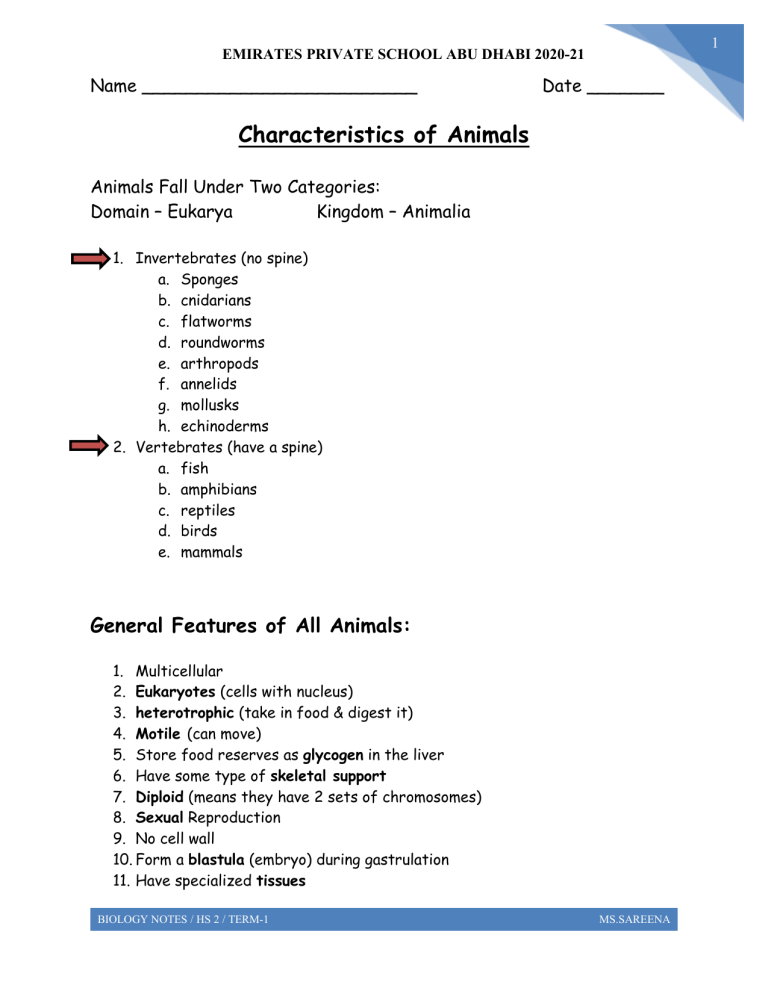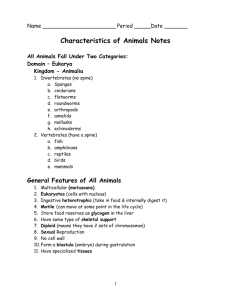
1 EMIRATES PRIVATE SCHOOL ABU DHABI 2020-21 Name _________________________ Date _______ Characteristics of Animals Animals Fall Under Two Categories: Domain – Eukarya Kingdom – Animalia 1. Invertebrates (no spine) a. Sponges b. cnidarians c. flatworms d. roundworms e. arthropods f. annelids g. mollusks h. echinoderms 2. Vertebrates (have a spine) a. fish b. amphibians c. reptiles d. birds e. mammals General Features of All Animals: 1. Multicellular 2. Eukaryotes (cells with nucleus) 3. heterotrophic (take in food & digest it) 4. Motile (can move) 5. Store food reserves as glycogen in the liver 6. Have some type of skeletal support 7. Diploid (means they have 2 sets of chromosomes) 8. Sexual Reproduction 9. No cell wall 10. Form a blastula (embryo) during gastrulation 11. Have specialized tissues BIOLOGY NOTES / HS 2 / TERM-1 MS.SAREENA 2 EMIRATES PRIVATE SCHOOL ABU DHABI 2020-21 Gastrulation: 1. ZYGOTE (fertilized egg) cleavage (rapid mitotic divisions) forms MORULA ( solid ball of cells) forms BLASTULA (hollow ball of cells with fluid-filled center called BLASTOCOEL) 2. Blastula folds inward forming an opening called the BLASTOPORE (may become the mouth OR anus) 3. Process of infolding is known as GASTRULATION 4. Forms multiple GERM LAYERS (tissues) in all animals except Poriferans (sponges) 5. GASTRULA stage has a single opening into a primitive gut called the ARCHENTERON BIOLOGY NOTES / HS 2 / TERM-1 MS.SAREENA 3 EMIRATES PRIVATE SCHOOL ABU DHABI 2020-21 Germ (TISSUE) Layers: All animals have outer ectoderm and inner endoderm – Diploblastic Animals with bilateral symmetry have 3 layers – Triploblastic Diploblastic Animals – Cnidarians Triploblastic Animals – all worms, arthropods, mollusks, echinoderms, & vertebrates 1. Ectoderm – exterior layer of tissue a. Develops into the skin, nervous system, and sensory organs 2. Mesoderm – middle layer (only present in animals with bilateral symmetry) a. Develops into skeleton, muscle, excretory system 3. Endoderm – interior layer a. Develops into the digestive system, respiratory system, etc. Animals May Show Symmetry (arrangement of body parts around an axis) 1. Asymmetrical – no symmetry (sponges) 2. Radial Symmetry – symmetry in the shape of a wheel; body parts arranged in a circle around a center axis (cnidarians, echinoderms) 3. Bilateral Symmetry – symmetry in which there is a right and left side that are mirror images and anterior (head) and posterior (tail) end (worms, arthropods, and all vertebrates) BIOLOGY NOTES / HS 2 / TERM-1 MS.SAREENA 4 EMIRATES PRIVATE SCHOOL ABU DHABI 2020-21 Animals May Show Cephalization: Sensory organs concentrated at the anterior or head end of the organism Always have bilateral symmetry (worms, arthropods, vertebrates) Animals May Show Segmentation: Only present in more complex animals May occur internally, externally, or both Repetition of body parts (vertebrae, ribs) Segments may be fused such as cephalothorax covering head and chest of crayfish Earthworms (internal & external); vertebrates (internal) Most Animals Have a Body Cavity: Coelom – true body cavity fully lined (top and bottom) with mesoderm Acoelomate – animal with no coelom (flatworms) Pseudocoelomate – animal with a “false” coelom only partially lined with mesoderm (roundworms) Coelomate – animal with a true coelom that is fully lined with mesoderm (mollusks, arthropods, echinoderms, & vertebrates) ACOELOMATE BIOLOGY NOTES / HS 2 / TERM-1 PSEUDOCOELOMATE COELOMATE MS.SAREENA 5 EMIRATES PRIVATE SCHOOL ABU DHABI 2020-21 Body Surfaces: Anterior – toward the head Posterior – toward the anus Dorsal – toward the spine (back) Ventral – toward the stomach (belly button) Lateral – to the side Oral – side where the mouth is located Aboral – side opposite the surface where the mouth is located Types of Animals: Phylum Examples Derived Characteristics (evolved characteristic) Porifera sponges multicellular Cnidaria jellyfish, hydra, coral tissues Platyhelminthes flatworms bilateral symmetry Nematoda roundworms pseudocoelom Mollusca clams, squids, snails coelom Annelida earthworms, leeches segmentation Arthropoda insects, spiders, crustaceans jointed appendages Echinodermata starfish deuterostomes Chordata vertebrates notochord BIOLOGY NOTES / HS 2 / TERM-1 MS.SAREENA 6 EMIRATES PRIVATE SCHOOL ABU DHABI 2020-21 Metamorphosis: May be complete or incomplete Most common in ARTHROPODS Incomplete (egg nymph adult) Complete (egg larva pupa adult) INCOMPLETE COMPLETE Support Systems: Sponges are the simplest animals supported by spongin (protein) and spicules Limestone cases support coral polyps (animals) Worms have fluid-filled body cavities making a hydrostatic skeleton muscles push against Arthropods have outside exoskeletons that must be shed or molted to grow Echinoderms (star fish) & vertebrates have internal endoskeletons Animal Body Systems: Digestion All animals are ingestive heterotrophs Sponges have specialized cells called amebocytes that digest food and carry it to cells Cnidarians (jellyfish, coral. sea anemones) o Have a two-way digestive system (single opening where food enters and wastes leave) o Gastrovascular Cavity – body cavity where digestion occurs BIOLOGY NOTES / HS 2 / TERM-1 MS.SAREENA 7 EMIRATES PRIVATE SCHOOL ABU DHABI 2020-21 Annelids, Arthropods, Vertebrates o One-way digestive tract with a mouth & anus o Food for food intake o Anus for waste expelling Circulation How oxygen, carbon dioxide, nutrients, and wastes are transported throughout the body Circulation may be OPEN or CLOSED system Open Circulatory System – two main blood vessels (dorsal and ventral); heart pumps blood out into vessels that open into the body cavity for gas and nutrient exchange Closed Circulatory System – heart pumps blood through enclosed vessels and capillaries deliver to cells Respiration Respiration - taking in oxygen, releasing carbon dioxide Diffusion across moist surfaces (earthworm) Gills in aquatic animals Lungs in terrestrial animals Nervous Nervous System - coordinates the activities of the animal body Neurons - nerve cells that send impulses Nerve Net - network of neurons, very little coordination Ganglion - clusters of neurons (simple brain) Brain - sensory structures and neurons located at anterior end, complex coordination and behavior BIOLOGY NOTES / HS 2 / TERM-1 MS.SAREENA 8 EMIRATES PRIVATE SCHOOL ABU DHABI 2020-21 Support Support -how the body maintains its shape Hydrostatic skeleton - water pressure (jellyfish, worms) Exoskeleton - outside skeleton (insects and crabs) Endoskeleton - inside skeleton (vertebrates) Excretion Excretion - the removal of wastes from the body Diffusion can release wastes in simple aquatic animals Flame cells in flatworms Nephridia in arthropods Excretory system in terrestrial animals (kidneys) removes waste without loss of water Reproduction Reproduction - process by which organisms make more of their own kind Asexual reproduction - reproduction only needs 1 parent, offspring are identical Regeneration - fragmentation and regrowth (sponges) Budding - growth of a clone(bud) and release (hydra) Parthenogenesis - rare, individual develops from unfertilized eggs Sexual reproduction - reproduction involves the joining of egg and sperm (2 parents) Hermaphrodite - animals that produce both egg & sperm, have both sexes (earthworm) External Fertilization - sperm is released into water where it fertilizes eggs in the water Internal Fertilization - sperm and egg join within the body of the female BIOLOGY NOTES / HS 2 / TERM-1 MS.SAREENA


